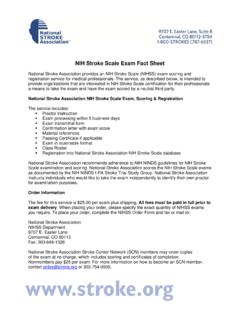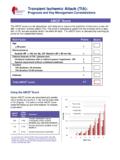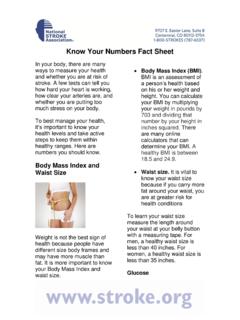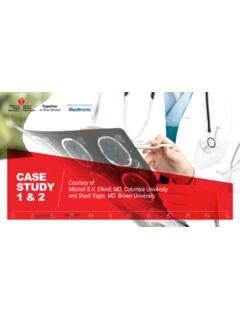Transcription of ASSESSING STROKE –SCORES & SCALES
1 111 ASSESSING STROKE SCORES & SCALESAUTHORS: JULIE FUSSNER, BSN, RN, CPHQ, SCRNCESAR VELASCO, RN2 DISCLOSURESJULIE FUSSNER I have no actual or potential conflict of interest in relation to this VELASCO I have no actual or potential conflict of interest in relation to this SCALES Discuss the most current, relevant scoring systems and SCALES being used for the STROKE population Identify the strengths, limitations, and application of these SCALES Recognize each scoring system and scale property that is important and relevant to all assessment tools4 WHY ARE SCORING SYSTEMS AND SCALES USED? Assess the impact of therapeutic interventions in research Aids in improving diagnostic accuracy Helps determine clinical pathways of treatment Severity measurement Handoff Communication Assists in predicting and evaluating a patient s clinical outcomeA ONE SIZE FITS ALL APPROACH DOES NOT APPLY TO STROKE EVALUATION AND TREATMENT.
2 3435 SCORING SYSTEMS AND SCALESPREHOSPITAL STROKE ASSESSMENT SCALES Cincinnati Prehospital STROKE scale (CPSS) Los Angeles Prehospital STROKE scale (LAPSS) Rapid Arterial oCclusion Evaluation scale (RACE)ACUTE ASSESSMENT SCALES Glasgow Coma scale (GCS) NIH STROKE scale (NIHSS) Intracerebral Hemorrhage scale (ICH) FUNCTIONAL ASSESSMENT SCALES Berg Balance scale Modified Rankin scale (mRS)OUTCOME ASSESSMENT SCALES Barthel Index Glasgow Outcome ScaleOTHER DIAGNOSTIC & SCREENING TEST Hachinski Ischaemia Score Hamilton Rating scale for Depression6 DEFINITIONS SENSITIVITY Sensitivity also called the true positive rate measures the proportion of actual positives that are correctly identified Refers to a test's ability to designate an individual with disease as positive.
3 A highly sensitive test means that there are few false negative results, and thus fewer cases of disease are missed. SPECIFICITY Specificity also called the true negative rate measures the proportion of actual negatives that are correctly identified The percentage of healthy people who are correctly identified as not having the condition Specificity avoids false positives5647 PREHOSPITAL STROKE ASSESSMENT SCALESCINCINNATI PREHOSPITAL STROKE scale (CPSS) Identifies facial paresis, arm drift, and abnormal speech. 80% of STROKE patients will exhibit one or more of these symptoms. However, it has the same limitations for certain STROKE -related deficits that can occur in isolation. Does not identify posterior circulation strokes Strength: Quick and easy for EMS to use 87859 PREHOSPITAL STROKE ASSESSMENT SCALES (CONTINUED)LOS ANGELES PREHOSPITAL STROKE scale (LAPSS) Assesses for unilateral deficit facial paresis, hand grip weakness, and arm drift Pre-hospital STROKE screening criteria:1.
4 Patient is >45 years of age2. Has no history of seizure/epilepsy3. Symptom duration is < 24 hours4. Patient is not bedridden or wheelchair dependent at baseline5. Blood glucose is between 60-400 mg/dL. Sensitivity =91% and Specificity =97% Strength: Allows rapid identification while excluding common mimics Limitation: Number of items for EMS to complete10910611 PREHOSPITAL STROKE ASSESSMENT SCALES (CONTINUED)SEVERITY SCALES FOR LARGE VESSEL OCCLUSION 2018 AHA Guidelines: Uncertainty exists over optimal algorithm and optimal prehospital LVO screen RACE: Rapid Arterial Occlusion Evaluation LAMS: Los Angeles Motor scale FAST-ED:Field Assessment STROKE Triage for Emergency Destination CSTAT: Cincinnati Prehospital STROKE Severity scale VAN: Vision, Aphasia, Neglect Assessment MEND: Miami Emergency Neurologic Deficit ROSIER.
5 Recognition of STROKE in the Emergency Room Off hand, I d say your suffering from an arrow through your head, but just to play it safe, I m going to conduct a bunch of STROKE ASSESSMENT SCALES (CONTINUED)SEVERITY SCALES FOR LARGE VESSEL OCCLUSION Why you can t have a perfect scale : Up top 29% of patient with baseline of NIHSS =0 had a proximal occlusion on CTA Most SCALES are subsets of NIHSS scores Patients with ICH, post seizure paralysis, hyperglycemia in the field can have high NIHSS1112713 PREHOSPITAL STROKE ASSESSMENT SCALES (CONTINUED)RAPID ARTERIAL OCCLUSION EVALUATION scale (RACE) This tool is based on the items of the NIHSS with the highest predictive value for large vessel occlusion (LVO). Focuses on facial palsy, extremity motor function, head and gaze deviation, and aphasia or agnosia.
6 The RACE scale score range is 0-9 points RACE scale score >5 points is associated with detection of a LVO RACE has as a sensitivity of 85% and specificity of 68%14 ITEMINSTRUCTIONSCOREF acial palsyAsk patient to smileAbsent = 0 Mild = 1 Moderate to severe = 2 Arm motor functionExtend patient s arm 90 degrees if sitting; 45 degrees if supineNormal to mild = 0 Moderate = 1 Severe = 2 Leg motor functionExtend patient s leg 30 degrees in supine positionNormal to mild = 0 Moderate = 1 Severe = 2 Head and gaze deviationObserve deviation to one sideAbsent = 0 Present = 1 Aphasia (right side)Ask patient to close their eyes and make a fistNormal = 0 Moderate = 1 Severe = 2 Agnosia (left side)Ask patient to recognize familiar objectsNormal = 0 Moderate = 1 Severe = 2 RAPID ARTERIAL OCCLUSION EVALUATION scale (RACE)1314815 ACUTE ASSESSMENT SCALESGLASGOW COMA scale (GCS) Identifies ocular, verbal, and motor response to examination Tool is used to communicate the level of consciousness (LOC)
7 Of patients with an acute brain injury The scale was developed to complement and not replace assessments of other neurological functions Strength: Fast and easy to use Limitation: Developed as a trauma scale . STROKE patient with plegic arm can be scored a 6 on the motor response if they follow commands 161516917 ACUTE ASSESSMENT SCALES18 ACUTE ASSESSMENT SCALESNATIONAL INSTITUTES OF HEALTH STROKE scale (NIHSS) Uses a 11 Item scale to measure neurological impairment Originally developed to be a research tool for Alteplase patients to determine 90 day outcomes NIHSS has become the gold standard scale in clinical trials and as part of clinical practice in the United States Baseline NIHSS scores are predictive values of an acute STROKE patient s clinical outcomes Quality metric for PSC, TSC and CSC Certifications Score what the patient does, not what you think they can do 17181019 Scoring range is 0-42 points.
8 The higher the number, the greater the INSTITUTES OF HEALTH STROKE scale (NIHSS)ScoreStroke Severity0No STROKE symptoms1-4 Minor stroke5-15 Moderate stroke16-20 Moderate to severe stroke21-42 Severe stroke20 ACUTE ASSESSMENT SCALESNATIONAL INSTITUTES OF HEALTH STROKE scale (NIHSS) Strength: Reliable tool to rapidly assess effects of STROKE Medical providers and registered nurses expertly trained in the use of the scale are proven to have similar levels of accuracy Further reliability improved through the use of a standard training video Limitation: Tool does not capture ALL STROKE -related impairments Unsteady gait, dizziness, or diplopia attributed to posterior circulation STROKE More complicated with patient in coma, intubated or aphasic 19201121 ACUTE ASSESSMENT SCALESINTRACEREBRAL HEMORRHAGE scale (ICH SCORE) Uses a 5-item scale Predictor of 30 day mortality Developed to standardize clinical grading to improve communication and consistency between healthcare providers.
9 Sensitivity =66% in predicting 30 day mortality 22 FUNCTIONAL ASSESSMENT SCALESBERG BALANCE scale (BBS) 14-item scale designed to measure the balance of older patients in the clinical setting Scoring range is 0-4 points. The greater the number, the higher the level of function. 41-56= Independent 21-40= Walking with assistance 0-20= Wheelchair bound Sensitivity= 91% and Specificity= 82%Patient with a score < 55 and history of falls is at a greater risk of fallingPatient with a score < 40 has a 100% risk of falling2122122324 FUNCTIONAL ASSESSMENT SCALESMODIFIED RANKIN scale (mRS) 7-grade scale measuring functional independence and gait stability mRS has been used to measure STROKE outcomes and functional impact post- STROKE The scale is used a core metric of Comprehensive STROKE Centers.
10 Evaluating 90-day clinical outcomes of post-IV tPA(Alteplase) or endovascular intervention (EVT) patients A mRS score appears to show moderate correlation with the volume of cerebral infarction Good Outcome: 0-22324132526 OUTCOME ASSESSMENT SCALESBARTHEL INDEX (BI) The index measures 10 basic aspects of self-care and patient s physical dependency. A normal Barthel Index score = 100 >60 = Assisted independence <40 = Severe dependency Strength: An excellent validity and reliability rate and widely used for STROKE . Limitation: A low sensitivity for high-level functioning or chronically ADL INDEX: GUIDELINES1. The index should be used as a record of what a patient does, not as a record of what a patient could The main aim is to establish degree of independence from any help, physical or verbal, however minor and for whatever The need for supervision renders the patient not A patient s performance should be established using the best available evidence.










